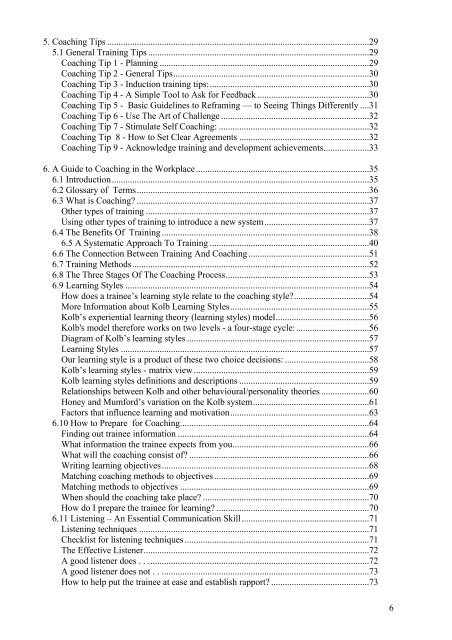How to Perform On-the-job Training - Dean Amory
According to The Encyclopedia of Business, ©2000 Gale Cengage, On-the-job training is by far the predominant form of job training. Studies also indicate that it is the most effective form of job training. Yet, it also represents a significant investment considering that roughly 30% of a new worker's time is spent in on-the-job training during the first 90 days of employment, that productivity of experienced workers assigned to train new workers may decrease during the training period, and that new workers may make expensive mistakes. Both companies and workers therefore profit largely from the presence of simple, but complete trainee and trainer guides that allow for executing OJT in a structured way. “How to perform on-the-job training”, has the information, techniques and tips that will allow you to implement a professional OJT training program. The book also includes all the tools, documents and checklists necessary for setting up a qualitative and efficient skills training program for OJT coaches
According to The Encyclopedia of Business, ©2000 Gale Cengage, On-the-job training is by far the predominant form of job training. Studies also indicate that it is the most effective form of job training. Yet, it also represents a significant investment considering that roughly 30% of a new worker's time is spent in on-the-job training during the first 90 days of employment, that productivity of experienced workers assigned to train new workers may decrease during the training period, and that new workers may make expensive mistakes.
Both companies and workers therefore profit largely from the presence of simple, but complete trainee and trainer guides that allow for executing OJT in a structured way.
“How to perform on-the-job training”, has the information, techniques and tips that will allow you to implement a professional OJT training program. The book also includes all the tools, documents and checklists necessary for setting up a qualitative and efficient skills training program for OJT coaches
Create successful ePaper yourself
Turn your PDF publications into a flip-book with our unique Google optimized e-Paper software.
5. Coaching Tips ...................................................................................................................29<br />
5.1 General <strong>Training</strong> Tips .................................................................................................29<br />
Coaching Tip 1 - Planning ............................................................................................29<br />
Coaching Tip 2 - General Tips......................................................................................30<br />
Coaching Tip 3 - Induction training tips:......................................................................30<br />
Coaching Tip 4 - A Simple Tool <strong>to</strong> Ask for Feedback .................................................30<br />
Coaching Tip 5 - Basic Guidelines <strong>to</strong> Reframing — <strong>to</strong> Seeing Things Differently ....31<br />
Coaching Tip 6 - Use The Art of Challenge .................................................................32<br />
Coaching Tip 7 - Stimulate Self Coaching: ..................................................................32<br />
Coaching Tip 8 - <strong>How</strong> <strong>to</strong> Set Clear Agreements .........................................................32<br />
Coaching Tip 9 - Acknowledge training and development achievements....................33<br />
6. A Guide <strong>to</strong> Coaching in <strong>the</strong> Workplace ............................................................................35<br />
6.1 Introduction.................................................................................................................35<br />
6.2 Glossary of Terms......................................................................................................36<br />
6.3 What is Coaching? ......................................................................................................37<br />
O<strong>the</strong>r types of training ..................................................................................................37<br />
Using o<strong>the</strong>r types of training <strong>to</strong> introduce a new system..............................................37<br />
6.4 The Benefits Of <strong>Training</strong> ...........................................................................................38<br />
6.5 A Systematic Approach To <strong>Training</strong> ......................................................................40<br />
6.6 The Connection Between <strong>Training</strong> And Coaching .....................................................51<br />
6.7 <strong>Training</strong> Methods........................................................................................................52<br />
6.8 The Three Stages Of The Coaching Process...............................................................53<br />
6.9 Learning Styles ...........................................................................................................54<br />
<strong>How</strong> does a trainee’s learning style relate <strong>to</strong> <strong>the</strong> coaching style?.................................54<br />
More Information about Kolb Learning Styles.............................................................55<br />
Kolb’s experiential learning <strong>the</strong>ory (learning styles) model.........................................56<br />
Kolb's model <strong>the</strong>refore works on two levels - a four-stage cycle:................................56<br />
Diagram of Kolb’s learning styles ................................................................................57<br />
Learning Styles .............................................................................................................57<br />
Our learning style is a product of <strong>the</strong>se two choice decisions: .....................................58<br />
Kolb’s learning styles - matrix view .............................................................................59<br />
Kolb learning styles definitions and descriptions .........................................................59<br />
Relationships between Kolb and o<strong>the</strong>r behavioural/personality <strong>the</strong>ories .....................60<br />
Honey and Mumford’s variation on <strong>the</strong> Kolb system...................................................61<br />
Fac<strong>to</strong>rs that influence learning and motivation.............................................................63<br />
6.10 <strong>How</strong> <strong>to</strong> Prepare for Coaching...................................................................................64<br />
Finding out trainee information ....................................................................................64<br />
What information <strong>the</strong> trainee expects from you............................................................66<br />
What will <strong>the</strong> coaching consist of? ...............................................................................66<br />
Writing learning objectives...........................................................................................68<br />
Matching coaching methods <strong>to</strong> objectives ....................................................................69<br />
Matching methods <strong>to</strong> objectives ...................................................................................69<br />
When should <strong>the</strong> coaching take place? .........................................................................70<br />
<strong>How</strong> do I prepare <strong>the</strong> trainee for learning? ...................................................................70<br />
6.11 Listening – An Essential Communication Skill........................................................71<br />
Listening techniques .....................................................................................................71<br />
Checklist for listening techniques .................................................................................71<br />
The Effective Listener...................................................................................................72<br />
A good listener does . . .................................................................................................72<br />
A good listener does not . . ...........................................................................................73<br />
<strong>How</strong> <strong>to</strong> help put <strong>the</strong> trainee at ease and establish rapport? ...........................................73<br />
6


















